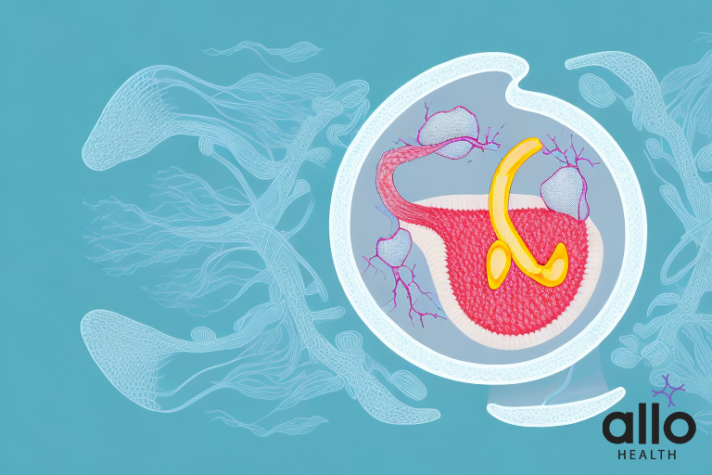Is Pelvic Inflammatory Disease an STD?

Allo Health is dedicated to personalized well-being, offering support and trusted information tailored to individual health goals. The platform emphasizes human-generated content, led by a distinguished medical team of experts, including physicians and sexual health specialists. Their commitment to credibility involves rigorous fact-checking, authoritative research, and continuous updates to ensure accurate, up-to-date information. Allo Health's unique approach goes beyond conventional platforms, providing expert-led insights and a continuous commitment to excellence, with user feedback playing a crucial role in shaping the platform's authoritative voice.

Dr. Aditi completed her undergraduate medical education at AJIMS, Mangalore, after which she worked in multi-speciality hospitals with COVID patients and in the Pain and Palliative medicine department. Driven by her experiences, she developed a keen interest in psychiatry. Dr. Aditi believes that mental health is just as, if not more important, than physical health.
Why This Was Upated?
Our experts continually monitor the health and wellness space, and we update our articles when new information became available.
Updated on 25 May, 2024
- Article was updated as part of our commitment to diversity, equity, and inclusion.

"The following blog article provides general information and insights on various topics. However, it is important to note that the information presented is not intended as professional advice in any specific field or area. The content of this blog is for general educational and informational purposes only.
Book consultation
The content should not be interpreted as endorsement, recommendation, or guarantee of any product, service, or information mentioned. Readers are solely responsible for the decisions and actions they take based on the information provided in this blog. It is essential to exercise individual judgment, critical thinking, and personal responsibility when applying or implementing any information or suggestions discussed in the blog."
Pelvic Inflammatory Disease, or PID, is a serious infection in the reproductive system of women. It can cause a variety of symptoms and can lead to complications if left untreated. There is often confusion surrounding the cause of PID, with many people wondering if it is an STD. In this article, we will explore the causes, symptoms, and treatments of PID, as well as the link between this condition and sexually transmitted diseases.
Pelvic Inflammatory Disease Overview
Pelvic Inflammatory Disease (PID) is an infection of a woman’s reproductive organs. It typically occurs when bacteria from the vagina or cervix travel into the uterus, fallopian tubes, or ovaries, leading to inflammation and infection. PID can have serious consequences, including chronic pelvic pain, infertility, and an increased risk of ectopic pregnancy.
Here’s an overview of PID, including its causes, symptoms, diagnosis, treatment, and prevention:
Causes:
PID is often caused by sexually transmitted infections (STIs), most commonly chlamydia and gonorrhea. However, other bacteria found in the vagina can also contribute to the development of PID.
Risk Factors:
- Age: Women under 25 are at a higher risk.
- Multiple sexual partners: Having multiple sexual partners increases the risk of exposure to STIs.
- Previous PID: A history of PID increases the risk of recurrence.
- IUD use: Although rare, the risk of PID may slightly increase with intrauterine device (IUD) use.
- Douching: Douching may disrupt the normal balance of bacteria in the vagina, increasing the risk of infection.
Symptoms:
PID symptoms can vary in severity, and some women may not experience any noticeable symptoms. Common signs and symptoms include:
- Pelvic pain: Dull or sharp pain in the lower abdomen or pelvis.
- Abnormal vaginal discharge: Unusual color, consistency, or odor of vaginal discharge.
- Painful urination or intercourse: Discomfort during urination or sexual activity.
- Irregular menstrual bleeding: Changes in the menstrual cycle.
- Fever and fatigue: Systemic symptoms indicating infection.
Complications:
If left untreated, PID can lead to severe complications:
- Chronic pelvic pain: Long-term pain in the pelvic region.
- Infertility: Scarring and damage to the reproductive organs may result in infertility.
- Ectopic pregnancy: The risk of a fertilized egg implanting outside the uterus increases.
- Abscess formation: Pus-filled pockets may develop in the reproductive organs.
Diagnosis:
- Medical History: The healthcare provider will inquire about symptoms, sexual history, and previous infections.
- Physical Examination: Pelvic exam to check for tenderness, abnormal discharge, or swollen ovaries.
- Lab Tests: Tests for STIs, such as chlamydia and gonorrhea.
- Ultrasound: Imaging tests may be performed to check for abnormalities in the reproductive organs.
Treatment:
- Antibiotics: A combination of antibiotics is typically prescribed to target the bacteria causing the infection.
- Pain Management: Over-the-counter pain relievers or prescription medications may be recommended.
- Rest and Avoidance of Sexual Activity: Resting and abstaining from sexual activity until the infection clears.
Prevention:
- Safe Sex Practices: Using condoms consistently and correctly.
- Regular STI Testing: For sexually active individuals, routine testing for STIs can detect and treat infections early.
- Limiting Sexual Partners: Having a monogamous sexual relationship with a partner who has been tested and is free of STIs.
- Avoiding Douching: Douching can disrupt the natural balance of bacteria in the vagina.
PID is a serious condition that requires prompt medical attention. Early diagnosis and treatment are crucial to preventing complications. If you suspect you have PID or are experiencing symptoms, consult with a healthcare professional for proper evaluation and management.

Is Pelvic Inflammatory Disease an STD?
Yes, Pelvic Inflammatory Disease (PID) is often associated with sexually transmitted infections (STIs), although it can also be caused by other types of bacteria. The most common STIs linked to PID are chlamydia and gonorrhea. Let’s explore this relationship in more detail:
STD Connection:
- Chlamydia and Gonorrhea: These two bacterial infections are the primary culprits behind PID. When a person becomes infected with chlamydia or gonorrhea, the bacteria can ascend from the vagina and cervix into the upper reproductive organs, including the uterus, fallopian tubes, and ovaries.
- Bacterial Spread: The bacteria trigger an inflammatory response in the pelvic organs, leading to the characteristic symptoms of PID.
Other Bacterial Causes:
- Non-Sexually Transmitted Bacteria: While chlamydia and gonorrhea are common causes, other bacteria not typically considered sexually transmitted can also lead to PID. These bacteria may originate from the normal flora of the vagina or be introduced during medical procedures, childbirth, or pelvic surgery.
Transmission:
- Sexual Transmission: Chlamydia and gonorrhea are primarily transmitted through sexual contact, including vaginal, anal, or oral sex. Unprotected sex with an infected partner increases the risk of acquiring these infections.
- Non-Sexual Transmission: PID can also result from non-sexual factors, such as childbirth, abortion, or the insertion of intrauterine devices (IUDs), especially if proper aseptic techniques are not followed.
Risk Factors:
- Sexual Activity: Having multiple sexual partners or engaging in high-risk sexual behaviors increases the likelihood of encountering STIs that can lead to PID.
- Age: Younger women, particularly those under 25, are at a higher risk, possibly due to increased sexual activity and higher rates of chlamydia and gonorrhea in this age group.
Prevention:
- Safe Sex Practices: Using condoms consistently and correctly during sexual activity can significantly reduce the risk of contracting STIs.
- Regular STI Testing: Routine testing for STIs, especially in sexually active individuals, helps detect infections early and enables prompt treatment.
- Limiting Sexual Partners: Having a monogamous sexual relationship with a partner who is known to be free of STIs reduces the risk of exposure.
Consequences and Complications:
- Chronic Pelvic Pain: PID can lead to long-term pelvic pain.
- Infertility: Scarring and damage to the reproductive organs may result in infertility.
- Ectopic Pregnancy: The risk of a fertilized egg implanting outside the uterus increases.
- Abscess Formation: Pus-filled pockets may develop in the reproductive organs.
While PID is often associated with STIs, it can also be caused by other bacteria. The key to prevention lies in safe sex practices, regular STI testing, and seeking prompt medical attention if symptoms suggestive of PID arise. Early diagnosis and treatment are crucial to prevent complications and preserve reproductive health.
Most Asked Questions
-
Is Pelvic Inflammatory Disease (PID) always resulting from sexually transmitted infections (STIs)?
Pelvic inflammatory ailment (pid) can end result from each sexually transmitted infections (stis) and non-sexual factors. While chlamydia and gonorrhea are not unusual sti-associated causes, other micro organism now not typically considered sexually transmitted can also result in pid. Elements like childbirth, abortion, or the insertion of intrauterine devices (iuds) also can make a contribution to pid if right aseptic strategies aren't accompanied.
-
Can you get PID without undertaking sexual pastime?
Yes, it is feasible to increase pid with out carrying out sexual pastime. Even as stis like chlamydia and gonorrhea are commonplace causes, non-sexual factors which includes childbirth, abortion, or the insertion of intrauterine devices (iuds) can lead to pid. Retaining proper hygiene in the course of scientific methods and childbirth is essential to prevent bacterial introduction.
-
Are best women who engage in high-danger sexual conduct liable to PID?
No, all sexually lively women are at some risk of growing pid. Having more than one sexual companions or carrying out excessive-risk sexual conduct can boom the probability of encountering stis like chlamydia and gonorrhea, leading to pid. But, training secure sex, using condoms constantly and successfully, and ordinary sti testing can assist lessen the danger.
-
Can PID be caused by bacteria apart from chlamydia and gonorrhea?
Sure, pid can be because of bacteria aside from chlamydia and gonorrhea. At the same time as those two stis are primary culprits, different bacteria from the ordinary vaginal plant life or added in the course of clinical strategies, childbirth, or pelvic surgery also can lead to pid. It is crucial to take into account both sexual and non-sexual factors in the development of pid.
-
Is PID extra common in younger girls?
Yes, more youthful ladies, specifically those below 25, are at a higher risk of growing pid. This age organization often engages in better charges of sexual interest, increasing publicity to stis like chlamydia and gonorrhea. Training secure intercourse, proscribing sexual partners, and present process ordinary sti trying out can assist mitigate the hazard of pid in this populace.






































